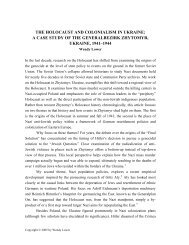Effects of Teachers' Mathematical Knowledge for Teaching on - Apple
Effects of Teachers' Mathematical Knowledge for Teaching on - Apple
Effects of Teachers' Mathematical Knowledge for Teaching on - Apple
You also want an ePaper? Increase the reach of your titles
YUMPU automatically turns print PDFs into web optimized ePapers that Google loves.
School Characteristics<br />
The single school characteristic used in this model was household poverty,<br />
or the percentage <str<strong>on</strong>g>of</str<strong>on</strong>g> households in poverty in the neighborhood census<br />
tract where schools were located. This measure was c<strong>on</strong>structed from 1990<br />
census data.<br />
Statistical Models and Estimati<strong>on</strong> Procedures<br />
Linear mixed models were used to estimate the influence <str<strong>on</strong>g>of</str<strong>on</strong>g> student, teacher,<br />
and school characteristics <strong>on</strong> gains in student achievement. All analyses were<br />
c<strong>on</strong>ducted with the PROC MIXED procedure in SAS. As described earlier, the<br />
main dependent variable was student gain scores over 1 year <str<strong>on</strong>g>of</str<strong>on</strong>g> participati<strong>on</strong><br />
in the study. The main advantage <str<strong>on</strong>g>of</str<strong>on</strong>g> using gain scores as opposed to covariate<br />
adjustment models that regress pretest scores <strong>on</strong> posttest scores is that gain<br />
scores are unbiased estimates <str<strong>on</strong>g>of</str<strong>on</strong>g> students’ academic growth (Mullens et al.,<br />
1996; Rogosa, Brandt, & Zimowski, 1982; Rogosa & Willett, 1985). However,<br />
gain scores can be subject to unreliability, and, as a result, readers are cauti<strong>on</strong>ed<br />
that the effects <str<strong>on</strong>g>of</str<strong>on</strong>g> independent variables <strong>on</strong> the outcome measure are undoubtedly<br />
underestimated (Rowan, Correnti, & Miller, 2002).<br />
We elected to exclude c<strong>on</strong>siderati<strong>on</strong> <str<strong>on</strong>g>of</str<strong>on</strong>g> a number <str<strong>on</strong>g>of</str<strong>on</strong>g> factors from our<br />
statistical models <str<strong>on</strong>g>for</str<strong>on</strong>g> simplicity <str<strong>on</strong>g>of</str<strong>on</strong>g> the results presented and discussi<strong>on</strong> <str<strong>on</strong>g>of</str<strong>on</strong>g><br />
these results. One such factor was instructi<strong>on</strong>al practice, as reported <strong>on</strong> the<br />
daily mathematics log. Another was the mathematics curriculum materials<br />
used by each school, including whether the school was using the mathematics<br />
program recommended by the school improvement program. A third<br />
was the improvement program selected by the school. Although each <str<strong>on</strong>g>of</str<strong>on</strong>g><br />
these factors is a potentially important influence <strong>on</strong> student achievement,<br />
results from initial models suggested that the effects <str<strong>on</strong>g>of</str<strong>on</strong>g> the factors <strong>on</strong> gains<br />
in student achievement were complex; <str<strong>on</strong>g>for</str<strong>on</strong>g> instance, they interacted with student<br />
background characteristics, as well as grade level. Notably, however,<br />
participati<strong>on</strong> in a Comprehensive School Re<str<strong>on</strong>g>for</str<strong>on</strong>g>m program had little independent<br />
main effect <strong>on</strong> students’ achievement gains, a finding that makes<br />
sense given that the programs under study focused mainly <strong>on</strong> instructi<strong>on</strong>al<br />
improvement in English language arts.<br />
As discussed earlier, there were substantial amounts <str<strong>on</strong>g>of</str<strong>on</strong>g> student attriti<strong>on</strong><br />
and missing data <strong>on</strong> key variables. First graders without spring-to-spring<br />
data and third graders without fall-to-fall assessment data were necessarily<br />
excluded from the analyses. Also, teachers were excluded from the analysis<br />
if they did not return any <str<strong>on</strong>g>of</str<strong>on</strong>g> the three teacher questi<strong>on</strong>naires, thus providing<br />
no in<str<strong>on</strong>g>for</str<strong>on</strong>g>mati<strong>on</strong> <strong>on</strong> their preparati<strong>on</strong> <str<strong>on</strong>g>for</str<strong>on</strong>g> teaching, years <str<strong>on</strong>g>of</str<strong>on</strong>g> experience, or c<strong>on</strong>tent<br />
knowledge <str<strong>on</strong>g>for</str<strong>on</strong>g> teaching mathematics. When teachers did return questi<strong>on</strong>naires<br />
but did not answer enough c<strong>on</strong>tent knowledge <str<strong>on</strong>g>for</str<strong>on</strong>g> teaching items<br />
to reas<strong>on</strong>ably generate a pers<strong>on</strong>-level score, we imputed their score. This<br />
resulted in roughly 10% <str<strong>on</strong>g>of</str<strong>on</strong>g> first-grade teachers and 20% <str<strong>on</strong>g>of</str<strong>on</strong>g> third-grade teachers<br />
whose scores were adjusted via mean imputati<strong>on</strong>. Mean mathematics<br />
instructi<strong>on</strong>al time and absence rates <str<strong>on</strong>g>for</str<strong>on</strong>g> teachers who did not log their math-<br />
390




